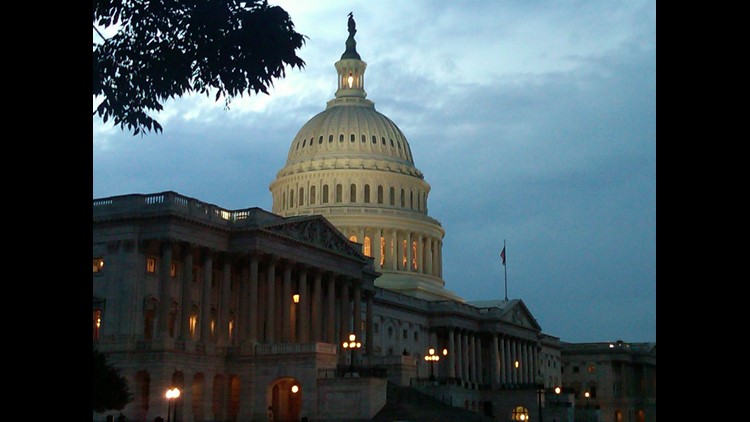(CNN) — Lawmakers return to the Capitol this week with negotiations over a crucial budget deal, in the words of one senior official involved, “as far away from agreement as they’ve been.”
Senate Republicans remain frustrated with the White House. House Democrats are engaged in their most significant internal battle of their majority. Neither party’s congressional leadership knows exactly what President Donald Trump would support or sign, aides on both sides say.
Reminder of what’s at stake: Congressional leaders are desperately seeking to forestall more than $120 billion in automatic spending cuts, as well as a catastrophic debt default. The preferred method is to strike an all-encompassing two-year budget deal. At this point, after several meetings of top negotiators, things have moved further away from a deal. The internal dynamics of the Democratic caucus laid bare by the immigration funding fight two weeks ago have only served to exacerbate concerns about any path to a final resolution.
Bottom line: The House and Senate are in session for a grand total of seven weeks before an end-of-September spending deadline, with a month-long August recess smack in the middle of it. While there is no agreement on a spending deal, or even the process of what’s next at the moment, there is agreement on this: things need to start moving, and fast.
Scheduling: As of now, there are no meetings scheduled between congressional leaders and top White House negotiators this week, aides say. That could change — and congressional aides have indicated they would like it to change in order to jump start talks — but as of now, nothing is on the books.
The new dynamic: For months there have been quiet questions in both chambers about whether Speaker Nancy Pelosi can wrangle her restive caucus on a big must-pass spending deal. Yet for all of those months Pelosi has demonstrated a tried and true ability to keep her caucus in line, despite grumbles and some limited public push back.
The fight over border funds, however, when House Democrats were forced to accept a bipartisan Senate agreement over their own measure, has served as very real flash point between the factions of the Democratic caucus — and the fallout has continued to percolate over the course of the 10-day congressional recess.
“This needs to be contained, and quickly,” one Democratic aide said in previewing lawmakers returning to Washington. “There are too many big issues out there in the weeks ahead for this to just fester.”
Any spending deal is going to have to include funding compromises on immigration issues, from funding for Immigration and Customs Enforcement to border barriers. In other words, it’s going to be even more problematic for progressives than the emergency border funding bill.
A potential problem
Treasury officials have signaled to Capitol Hill that the debt limit will be reached earlier than expected — sometime in mid-September, according to multiple sources briefed on the shifting date. That raises the specter of de-coupling the debt ceiling — one of the most valuable cudgels to force a budget deal by the end of September — from the spending talks if there isn’t progress in the weeks ahead.
The issue: The hold-up in bipartisan talks continues to be the increase in domestic, non-defense spending levels. It’s the piece of the deal that gets Democrats on board, and up to this point, they have remained far apart from a White House that is extremely uneasy about a sizable increase in spending on Democratic priorities. But to get the boost in defense spending Republicans want, the domestic spending piece has to be included. Everyone knows it, but it’s unclear at this point what will break the clear logjam between Democrats and the administration.
The complication: Democrats say the White House just needs to stay out of the negotiations and let congressional leaders reach a resolution. Republicans say Pelosi needs to reach an agreement with Trump for things to move forward. The reality is likely more the former than the latter — Senate Majority Leader Mitch McConnell has been clear he doesn’t want to move forward with anything he doesn’t have assurances Trump will sign, and the true rift is between the administration and Democrats over the domestic spending number. But McConnell’s also worked at length behind the scenes to bring the President around to the need for a deal.
The fallback: Administration officials caught everyone off guard by floating — publicly — that absent a deal they would accept a one-year continuation of government funding at the current fiscal year levels, along with delaying the automatic cuts and raising the debt ceiling. Democrats didn’t outright reject the idea, but said they could do better. Republicans, particularly defense hawks, were furious at the idea. McConnell deemed it “unacceptable” in remarks to reporters before the July 4 recess, as he continues his public (and, aides say, vigorous behind the scenes) push to reach a big deal.
The pushback
Sixteen GOP senators, led by Sen. David Perdue of Georgia, sent a letter to the top Trump administration spending negotiators urging them to drop the fallback plan out of concern it would hamstring the Pentagon’s ability to shift funds. Included in the group are several close White House allies and senators up for re-election in swing states in 2020.
Leaders in both chambers have made clear they will not allow the debt ceiling to lapse. Treasury Secretary Steven Mnuchin, one of the administration’s top negotiators, has said the same. On the spending fight, there are off-ramps, from short term continuing resolutions, to last minute agreements that break the seemingly unbridgeable divide. There’s a lot of time to get something done and agreed to, but there’s a palpable sense of concern right now that a big agreement, with clear bipartisan buy-in, that wraps everything up in a non-last second crisis manner, is slipping away, if not gone entirely.



